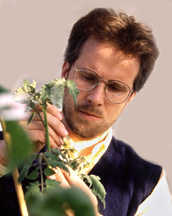 Purdue News
Purdue News
 Purdue News
Purdue News

|
"By understanding the mechanism of disease resistance in plants, we hope to improve the stability of their resistance, and move that trait into more crop plants," Martin says. "There are varieties of many crop plants that are resistant to certain diseases, but the disease-causing microbe evolves and the resistance breaks down. By learning how the plants and microbes recognize one another, we hope to create crop plants that have broader, more stable resistance."
According to Martin, the findings will have wide application. "It turns out that plants resist diverse pathogens -- including bacteria, fungi and viruses -- by using very similar defense mechanisms," he says. "By understanding how a plant recognizes one pathogen, we should begin to understand how plants identify many different pathogens."
The discovery of this protein-protein interaction is reported in today's (Friday, 12/20) issue of Science. The same issue of Science contains a second research paper that addresses different aspects of the recognition mechanism, which was written by researchers from the laboratory of Brian Staskawicz, professor of plant biology at the University of California, Berkeley.
The papers represent major breakthroughs in the understanding of the molecular basis of how plants resist diseases. "The field of plant disease resistance has just crystallized in the past two to three years," Martin says. "It has become one of the fastest-moving areas of plant biology."
Since the 1940s, when a scientist named H.H. Flor first proposed that disease resistance in plants requires both a dominant resistance gene in the plant and a dominant gene in the pathogen, scientists have struggled to determine if his "gene-for-gene" theory was correct and how it might work.
In 1993, Martin was successful in cloning the first disease-resistance gene in crop plants, Pto , which is involved in gene-for-gene disease resistance. But Martin and his colleagues at Purdue struggled to understand the molecular mechanism of disease resistance. One puzzle was why the protein that provides resistance to infection is found inside the cells instead of on the cell walls, where one would expect a defense mechanism to be.
A piece to the puzzle came from medical science, where researchers found in the early 1990s that a bacterium, Yersinia pseudotuberculosis , infects cells not by invading the cell wall, but by introducing proteins directly into the host cell's cytoplasm. Scientists have given this method of infection the name "type III secretion pathway."
Researchers found evidence that indicated that the type III secretion pathway also operated in plants, and Martin recognized that this pathway would explain why the kinase proteins are found in the plant cell cytoplasm, instead of on the cell wall.
Experiments in Martin's laboratory with the bacterium that causes bacterial speck disease in tomato confirmed that this is the mechanism for bacterial infections in plants. Martin and his colleagues found that after the bacterium infects the plant cell, the plant recognizes the invasion by identifying "signal" proteins, which are products of a specific gene in the bacterium Scientists have labeled this gene the "avirulence" gene, or avrPto , because in resistant plants it alerts the plants' defense mechanisms.
The bacterium's avrPto gene produces a protein that is bound in the plant cell cytoplasm by Pto kinase, which is produced by the plant resistance gene, Pto . This alerts the plant's various defense systems.
The resistance is effective only if the plant has the dominant resistance gene and the bacterium has the dominant "avirulence" gene.
Although Martin has discovered the molecular "how," the evolutionary "why" remains a strange mystery: Why would a microbe have a dominant gene that allows it to be recognized and repressed by its host? "It's as if the pathogen is in a dark room waving a flashlight and yelling 'I'm over here!' Why it does this is an ongoing puzzle," Martin says. "It's possible that the bacterial signal proteins may increase bacterial growth in plants that lack the resistance gene."
The research at Purdue is funded by the National Science Foundation and the David and Lucile Packard Foundation.
Source: Gregory B. Martin, (765) 494-4790; e-mail, gmartin@dept.agry.purdue.edu
Writer: Steve Tally, (765) 494-9809; e-mail, tally@ecn.purdue.edu
Purdue News Service: (765) 494-2096; e-mail, purduenews@purdue.edu
ABSTRACT
Photo caption:
Purdue plant scientist Gregory Martin examines a tomato plant used in experiments
to determine how plants fight disease. Martin and his colleagues have discovered
how plants fend off bacterial infections. (Purdue News Service file photo by David
Umberger.)
Color photo, electronic transmission, and Web and ftp download available. Photo ID:
Martin/Resistance
Download here